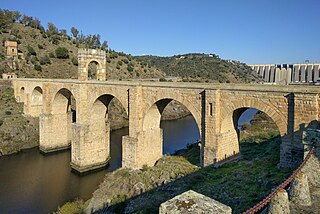
The ancient Romans were the first civilization to build large, permanent bridges. Early Roman bridges used techniques introduced by Etruscan immigrants, but the Romans improved those skills, developing and enhancing methods such as arches and keystones. There were three major types of Roman bridge: wooden, pontoon, and stone. Early Roman bridges were wooden, but by the 2nd century stone was being used. Stone bridges used the arch as their basic structure, and most used concrete, the first use of this material in bridge-building.

An arch bridge is a bridge with abutments at each end shaped as a curved arch. Arch bridges work by transferring the weight of the bridge and its loads partially into a horizontal thrust restrained by the abutments at either side. A viaduct may be made from a series of arches, although other more economical structures are typically used today.

The Severan Bridge is a late Roman bridge located near the ancient city of Arsameia, 55 km (34 mi) north east of Adıyaman in southeastern Turkey. It spans the Cendere Çayı, a tributary of Kâhta Creek, on provincial road 02-03 from Kâhta to Sincik in Adıyaman Province. This bridge was described and pictured in 1883 by archeologists Osman Hamdi Bey and Osgan Efendi. It is also has a photo and description in David George Hogarth's Wandering Scholar In The Levant, publ 1896, Chapter 4, a description of an 1894 visit (preface).

The Ponte Pietra, is a Roman arch bridge crossing the Adige River in Verona, Italy. The bridge was completed in 100 BC, and the Via Postumia from Genoa to Aquileia passed over it. It is the oldest bridge in Verona.

The Ponte das Taipas is a deck slab bridge across the Ave River in Caldas das Taipas, Portugal. Contrary to some sources which classify the structure as a Roman bridge, it was built in the modern age.

Constantine's Bridge was a Roman bridge over the Danube used to reconquer Dacia. It was completed in 328 AD and remained in use for four decades.

The Alcántara Bridge is a Roman bridge at Alcántara, in Extremadura, Spain. Alcántara is from the Arabic word al-Qantarah (القنطرة) meaning "the arch". The stone arch bridge was built over the Tagus River between 104 and 106 AD by an order of the Roman emperor Trajan in 98.
The Ponte San Lorenzo is a Roman bridge over the river Bacchiglione in Padua, Italy. Constructed between 47 and 30 BC, it is one of the very earliest segmental arched bridges in the world. It is also notable for the slenderness of its piers, unsurpassed in antiquity.

The Ponte Nomentano is a Roman bridge in Rome, Italy, which carried the Via Nomentana over the Aniene. Having lain outside the city limits for most of its history, the picturesque bridge is noted for its medieval bridge tower, which served to protect this important northern approach to Rome.

The Ponte Salario, also called Ponte Salaro during the Middle Ages, is a road bridge in Rome, Italy, whose origins date back to the Roman period. In antiquity, it lay outside the city limits, 3 km north of the Porta Collina, at the point where the Via Salaria crossed the Aniene, a tributary of the Tiber. The visible side arches are assumed to originate from the first stone structure built during the 1st century BC.

The Ponte Molino is a Roman bridge across the Bacchiglione in Padua, Italy. The span-to-rise ratio of the Late Republican bridge varies between 3.5–4.5 and 1, the ratio of clear span and pier thickness between 4–6.5 and 1.
The Ponte Corvo, rarely Ponte Corbo, is a Roman segmental arch bridge across the Bacchiglione in Padua, Italy. Dating to the 1st or 2nd century AD, its three remaining arches cross a branch of the river and are today partly buried respectively walled up. The span-to-rise ratio of the bridge varies between 2.8 and 3.4 to 1, the ratio of clear span to pier thickness from 4.9 to 6.9 to 1.

The Penkalas Bridge is a Roman bridge over the Penkalas, a small tributary of the Rhyndakos, in Aezani, Asia Minor.

The Eurymedon Bridge is a Roman bridge over the river Eurymedon near Selge in Pisidia in southern Turkey. It is part of the road winding up from the coastal region Pamphylia to the Pisidian hinterland. Located 5 km north of the village Beşkonak in a sparsely settled area, the bridge crosses the Eurymedon high above the valley bottom.

The Ain Diwar Bridge, also known as the Zangid Bridge, is a ruined masonry arch bridge, 3.5 km northeast of the town of Ain Diwar, Syria. The bridge is within vicinity of the Syria, Iraq and Turkey border region and about 500 m west of the Tigris River of which it used to cross.

The Bridge of Cava da Velha is a Roman bridge, situated in the civil parish of Castro Laboreiro e Lamas de Mouro, in the municipality of Melgaço in northern Portuguese district of Viana do Castelo.

The Eleutherna Bridge is an ancient Greek corbel arch bridge near the Cretan town of Eleutherna, Greece. A similar second bridge standing a short distance south of it collapsed toward the end of the 19th century, with only very few traces remaining.
The Susegana Bridge is one of a series of Roman bridges on the Via Claudia Augusta in Susegana, northern Italy. The small structure is notable for its flattened arch, which classify it as a Roman segmental arch bridge.
The Rhodes Footbridge is an ancient Greek arch bridge in the city of Rhodes, Greece. Dating to the 4th century BC or early Hellenistic period, the modest structure represents the oldest known Greek bridge with a voussoir arch.
















